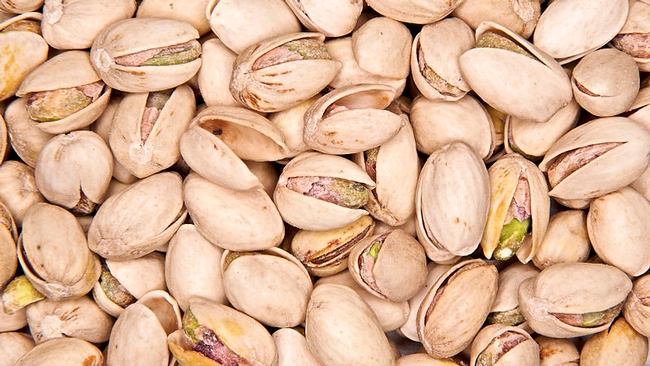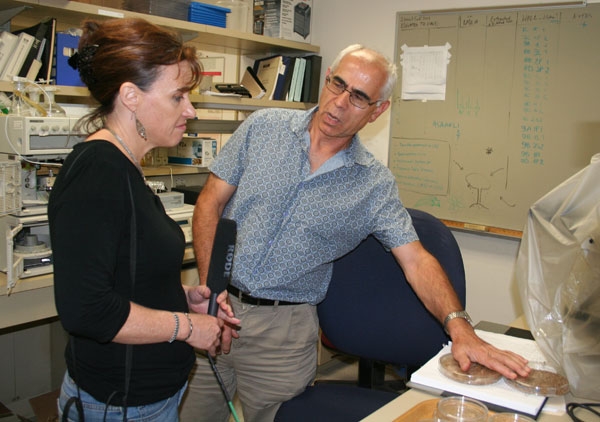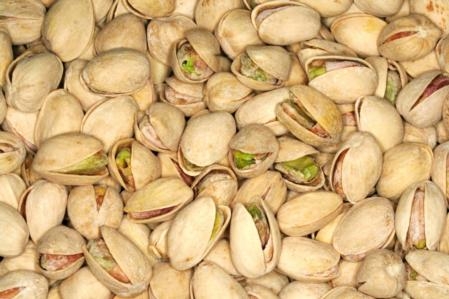Posts Tagged: pistachios
Too many California pistachios coming up empty
Some California pistachio farmers are facing one of their worst harvests ever, reported Sarah Zhang on Wired.com.
UC Agriculture and Natural Resources experts said the dip in yield cannot be blamed on the drought, but a warming climate may be coming into play. Pistachios require cold winter temperatures to reset their biological clocks.
“They use the temperature to know when winter is over,” said Craig Kallsen, UC Cooperative Extension advisor in Kern County. “And if they don't get the message, they get confused.”
Male trees then end up blooming after the female tree. If female plants don't get fertilized when they bloom, they still produce shells—just empty ones.
Kallsen said the hardest hit regions are in the Southern San Joaquin Valley.
"We're looking at a record low (yield)," Kallsen said.
Farmers to the north had more chilling hours, so they are seeing a normal or low number of empty pistachio shells.
Growers have found that spraying oil can help trees bloom more uniformly, however, it doesn't always seem to help, the story said.
“There are a lot of things we're still trying to understand,” said Gurreet Brar, UC Cooperative Extension advisor in Fresno County. “Oil applied at the wrong time or in inappropriate conditions like water stress conditions can injure the plant.”
Pistachio crop threatened by fungus
The California Report, a popular radio news program that is broadcast throughout the state on public radio stations, devoted five minutes this morning to a solution found at the UC Kearney Agricultural Research and Extension Center for a serious pistachio production problem.
Reporter Alice Daniel interviewed Kearney-based UC Davis plant pathologist Themis Michailides, who led the team that discovered how to expose pistachio trees to spores of a beneficial fungus that displaces the fungi that produce aflatoxin.
Though the story was broadcast this morning, it can still be heard on The California Report website and is embedded below:
For more information on the beneficial fungus, AF-36, which was used for the first time in commercial pistachio orchards this past summer, read Pistachio farmers enlist a beneficial fungus to battle aflatoxin.
California nut harvest winding down
- Almond growers expect to meet an early estimate of 1.95 billion pounds statewide, which would be a record
- Pistachio growers in the San Joaquin Valley are enjoying their second-largest crop ever after last year's record yield
- Walnut growers expect this year's yield to be 485,000 tons, slightly lower than last year's 503,000 tons
"The rumors I've heard is that guys are still complaining about the quality" of walnuts, said Rick Buchner, a University of California Cooperative Extension farm advisor in Red Bluff. "We're getting a lot of black husks on them, so there's a suggestion that we may have some husk breakdown and husk fly problems. It's probably too soon to tell yet."
Pistachio Association uses UC data to calculate the crop's economic impact
The economic impact of the pistachio industry in California, Arizona and New Mexico amounts to $1.9 million for each day of the year, $682.5 million annually, according to a report commissioned by the Western Pistachio Association. The greatest economic impact is in California, where the majority of pistachios are grown.
Consultant Dennis H. Tootelian arrived at these figures using data from the Census of Agriculture, USDA, CDFA, and the University of California Cooperative Extension's Sample Costs to Establish and Produce Pistachios, according to a news release WPA distributed today via PR Newswire.
"The goal of the study was to demonstrate the overall impact of the pistachio growers' spending and their ability to generate business activity, employment, personal income and tax revenue for other industries and the states they operate in overall," Tootelian was quoted in the release.
The $682.5 million economic impact takes into account the "ripple effect" of pistachio business activity. For example:
- Pistachio growers spend nearly $415.3 million each year to produce the pistachio crop
- This spending spurs creation of 5,910 full-time equivalent jobs each year
- The employment generates more than $224.4 million each year in wages and salaries for new employees, and expanded incomes for existing industry jobs
- More than $24.4 million annually in tax revenue and other business licenses and fees are generated
"This report shows us how we as an industry contribute to the economy – through substantial job creation, funding for community programs, literally millions in tax revenues to the states where growers operate – all by simply growing the best possible product for consumers," said WPA executive director Richard Matoian.
The complete economic impact report may be viewed on the Western Pistachio Association's website.

UCCE's pistachio cost study.
Salmonella scares roil consumers
Even though Salmonella scares are reverberating in the news media, UC Davis Cooperative Extension food safety specialist Linda Harris says that, overall, the nation's food supply is safe.
Comments from Harris, a food-safety microbiologist at the Western Institute for Food Safety and Security at UC Davis, appeared in a story by Barbara Anderson in today's Fresno Bee.
"I would hate for consumers to approach the grocery store with trepidation," Harris was quoted in a story published today. Most of the food in grocery stores, she told the reporter, has been processed in some way that reduces or eliminates Salmonella, she said.
However, the story outlined how easily Salmonella bacteria can makes their way into the food chain. The bacteria flourish in soil and water and can survive in a dry environment. They can be on almost any food, and just a few bacteria can make someone ill. Salmonella is the most common cause of foodborne illnesses nationwide, but it is still relatively rare.
It is now easier for health investigators to recognize a salmonella outbreak because of advances in DNA technology.
"We have better methods to tease out outbreaks that previously would have gone unrecognized," Harris was quoted.



